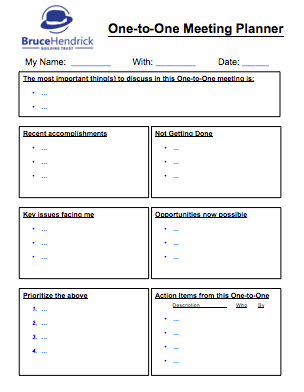So What Are We Supposed To Talk About?
Hello! Big apologies for the gap in this Building Trust Blog. Following one’s own advice carries consequences. Back in November I made a post in which I advised leaders to ask for help. Well that wasn’t theoretical; I’ve been busy justifying, identifying, hiring, and on-boarding a new General Manager for the RBB business. This gives both Building Trust and RBB new opportunities and fresh energy!
Simple One-to-One Prep Form
There are countless resources that describe effective interpersonal communications at work. Many refer to the concept of One-to-One conversations between co-workers, which are often but not always held between a supervisor and her subordinate.
In the Building Trust workshop, we invest considerable time developing the skills and techniques needed to create an open, constructive, 2-way dialog. We practice these skills in powerful and memorable 1-1 role-play scenarios.
Once the fundamentals of solid communications are in place, the next question is usually: “Great, but on a regular basis, what are we supposed to talk about?” That’s what the above one-page form is all about. It assumes that 1-1 meetings are held on some regular interval, whatever that might be.
Notice first that this is a one page form. Trial and error has taught me that anything longer than this tries to handle too many things in one session; anything shorter allows one or both parties to avoid or dance around critical items that probably need to be dealt with.
This preparation form is best completed by the subordinate before the meeting. It thereby promotes shared responsibility for outcomes and encourages the leader/supervisor to learn what the other person considers to be important. The preparer brings two copies to each meeting. Let’s discuss each section briefly.
The Most Important Thing(s) To Discuss In This One-to-One Is
- Whatever happens in the conversation, we absolutely must deal with these.
- Some choose to dive right into these first (especially if time is limited), some loop back around and use them to wrap up the 1-1.
- If the supervisor knows of something additional he wants to discuss, now’s the time to write it down.
Recent Accomplishments
- If you are like most busy professionals, you tend to gloss over these in search of the next problem or challenge facing you.
- Take a moment and acknowledge the good work that is being done. It adds great energy to the rest of the session.
- But keep moving!
Not Getting Done
- These are typically past Action Items or other objectives that have hit some kind of wall.
- Here is where the best coaching moments come from; instead of being a hero and resolving the barrier for the other person, use the opportunity to explore different approaches that may work.
- As either party commits to taking action, capture them in the Action Items section below.
Key Issues Facing Me
- Asking for help is tough… so I sneak in this softer way of doing so.
- This section differs from ‘Not getting done’ in that it is less task-based and more open-ended.
- Company politics, relationships, career and other stressors are par for this course.
- Don’t run from these issues – resolving these matters can be the most productive part of the 1-1 session.
Opportunities Now Possible
- The ideas here can get both parties into the habit of looking beyond the topics and crises of the day and into a potentially very different future.
- Many times I have encouraged my people to take strong action in these untapped areas rather than beat on old, intractable problems.
Prioritize The Above
- Whether this section was completed or not, now is a good time for both parties to align on priorities going forward.
- I find that a few moments spent here go a long way in staying productive and in sync with each other until the next One-to-One session.
Action Items From This One-to-One
- An Action Item without a deadline is a wish. Neither of you invested your valuable time to walk away now with merely hopes and wishes.
- Capture all the key commitments. If necessary use the back of the form.
- At your next One-to-One, be sure to hold each other accountable to these commitments.
As with any tool, I encourage the ODS reader to modify this planner to suit your specific needs. My only strong recommendation is to keep it one page in length.
As you employ this planner in your organization, please share your experiences with the rest of us. Thanks!
Download the One-to-One Meeting Planner in the Free Tools section of the Building Trust website.




